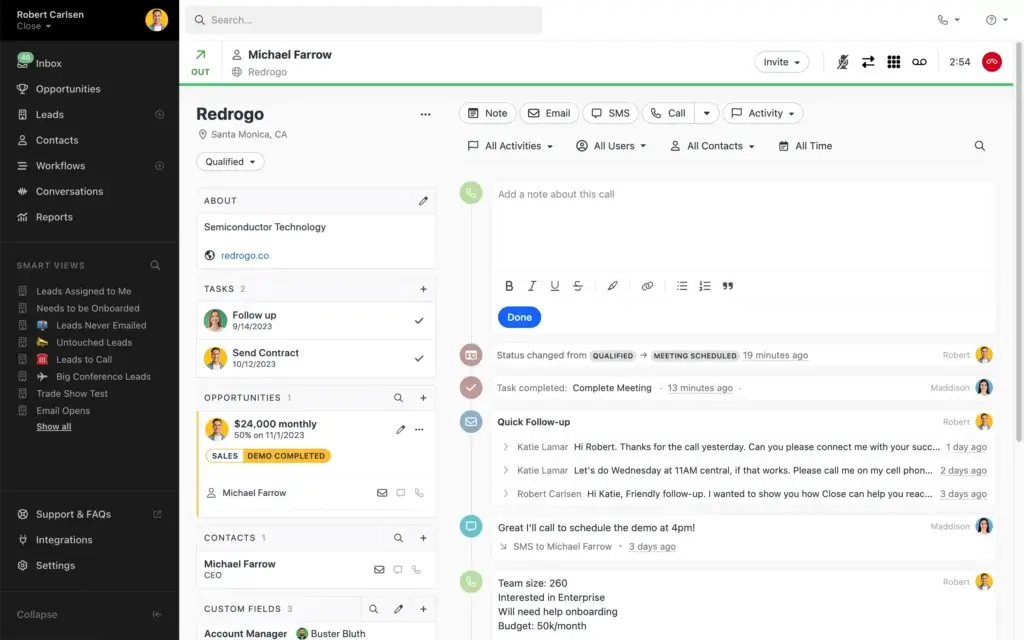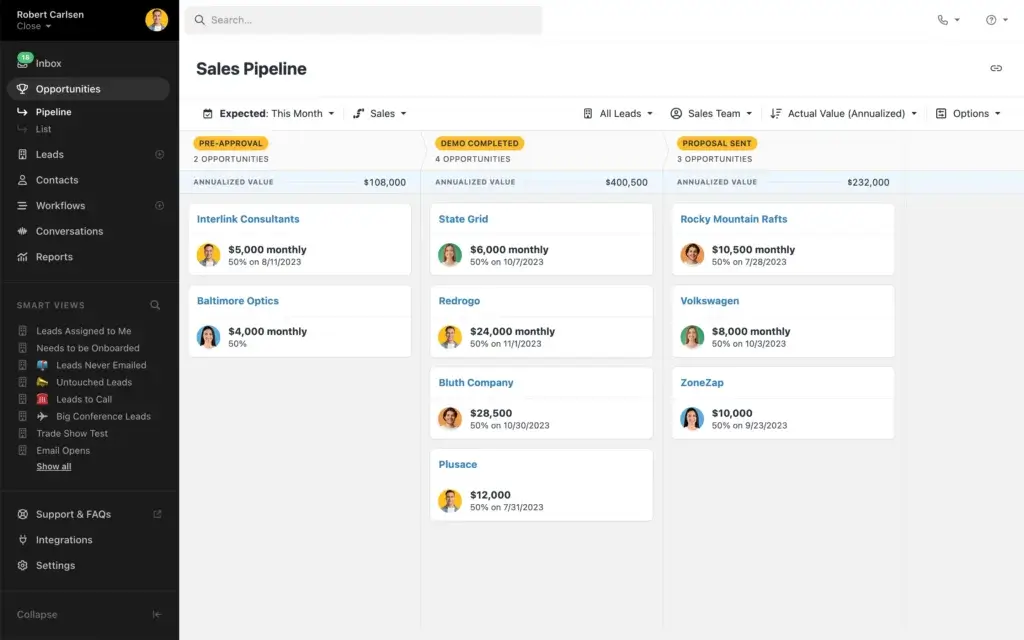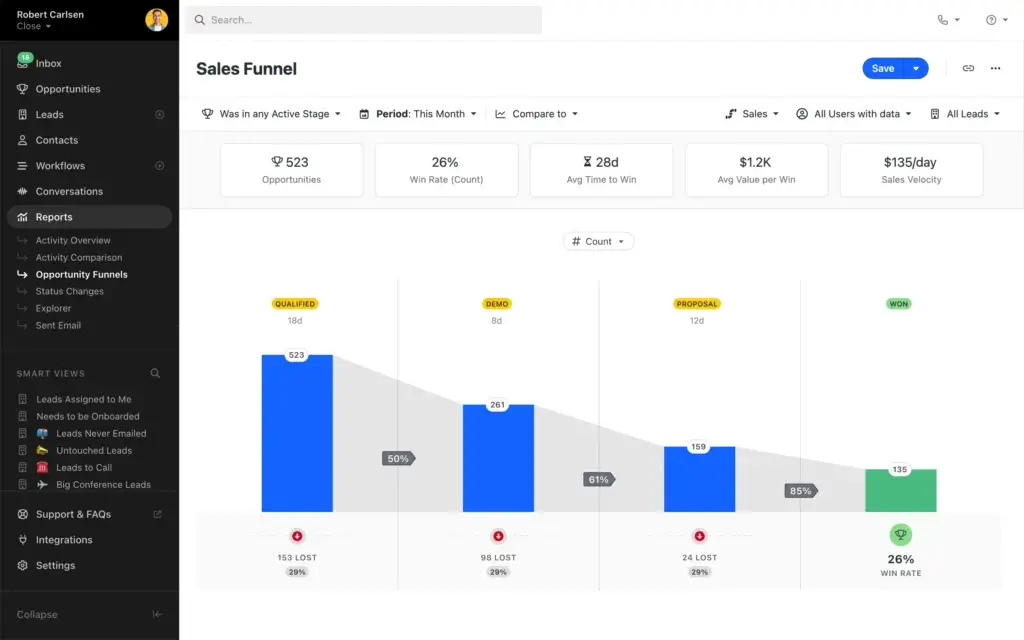Introduction
When choosing a customer relationship management (CRM) platform, you need more than a simple contact database. You need a system built around sales productivity – a tool that helps you communicate, track deals, forecast revenue, and collaborate without friction. Close CRM aims to deliver exactly that. Founded in 2013 as an outbound sales tool, Close has evolved into a sales engagement platform with built‑in calling, email, and SMS that aims to reduce context switching and help teams focus on closing deals.
In this comprehensive review, you’ll learn what sets Close CRM apart, what it does well, and where it falls short. You’ll see how its pricing tiers stack up, which types of teams gain the most benefit, and how it compares to other CRM platforms. By the end, you’ll be equipped to decide whether Close is the right fit for your business in the coming year.
Key Features
Close CRM Software specification
Close’s feature set is centred on sales engagement. The platform offers built‑in communication tools alongside pipeline management, automation, and analytics. Belo,w we break down its core capabilities.
Integrated communication tools
One of Close’s biggest differentiators is its integrated calling, SMS, and email capabilities. Within the CRM, you can:
- Place calls directly from your browser or mobile app with automatic logging of call recordings and outcomes.
- Send and receive emails using two‑way sync with Google Workspace or Microsoft 365, complete with templates, open tracking, and reply notifications.
- Send text messages to prospects in supported countries (US, Canada, UK, and Australia) from local numbers, keeping conversations in one thread.
Bringing all outreach into a single platform saves time and provides a complete communication history with each lead or customer. For busy sales teams that rely on volume outreach, this consolidation makes a noticeable difference.
Visual pipeline and deal management
Close lets you build visual sales pipelines with custom stages that reflect your sales process. Deals can be dragged and dropped between stages, and the system automatically logs related emails, calls, and tasks. You can create multiple pipelines to manage different products or market segments. Custom fields allow you to capture industry‑specific data, and Smart Views let you filter deals by stage, value, or expected close date. These features help you prioritise high‑value opportunities and spot bottlenecks.
Workflow automation
Automation in Close spans everything from follow‑up emails to task reminders. You can build email sequences that automatically send personalised messages based on triggers such as stage changes or time elapsed since last contact. Reminders ensure you always have a next step scheduled. On higher‑tier plans, you unlock predictive and power dialers for rapid outbound calling, as well as AI features that summarise call notes and extract action items. While Close lacks the advanced marketing automation found in some all‑in‑one CRMs, its sales‑focused workflows are robust enough to replace several separate tools.
Reporting and analytics
Data‑driven decision-making is crucial for modern sales teams. Close provides built‑in dashboards that display pipeline health, activity metrics, and revenue forecasting. Managers can track individual and team performance, monitor email open rates, and analyse call outcomes to identify areas for coaching. The more advanced plans include custom reports and deeper insights. However, some users report that lower‑tier plans offer limited analytics, so you may need external BI tools for sophisticated reporting.
AI‑powered enhancements
Close has introduced artificial intelligence to assist sales reps. An AI Call Assistant automatically transcribes conversations, identifies key action items, and even provides talk‑time analysis to improve your phone technique. The AI Email Assistant drafts follow‑up emails and summarises lead interactions. These features are available as paid add‑ons on higher tiers and can reduce administrative work, although they may not replace human judgment.
Integrations marketplace
While Close is designed to be an all‑in‑one sales tool, it recognises that businesses rely on broader tech stacks. The integrations marketplace includes connectors for communication apps like Zoom and Slack, marketing automation platforms like HubSpot and Mailchimp, document tools such as DocuSign and PandaDoc, and e‑commerce systems like Shopify and WooCommerce. A native API and Zapier integration allow you to build custom workflows across thousands of apps. Key integration categories include:
- Email and calendar: Google Workspace, Microsoft 365, Apple Calendar
- Communication: Zoom, Slack, Google Meet, Microsoft Teams
- Document management: DocuSign, PandaDoc, Google Drive, Dropbox
- Marketing automation: HubSpot, Mailchimp, ActiveCampaign, Drip
- Data enrichment: Clearbit, LeadFuze, Clay
- Customer support: Intercom, Drift, Zendesk
- Scheduling: Zeeg, Calendly, SavvyCal
These integrations ensure Close fits into your existing workflow and can grow with your business.
Mobile access and ease of use
Close offers fully functional iOS and Android apps that mirror the desktop experience. The mobile apps allow you to make calls, send SMS and emails, update deals and view dashboards on the go. Users consistently praise Close’s clean interface and short learning curve, noting that new reps can be productive within days rather than weeks. Smart Views and intuitive navigation encourage consistent use, which is critical for data accuracy and team adoption.
Security and compliance
Customer data security is non‑negotiable. Close meets industry standards with role‑based permissions, SSL encryption, and GDPR compliance. Enterprise plans add single sign‑on (SSO) for secure authentication, and advanced permissions let administrators control which users can view or edit sensitive information. The platform also supports granular audit logs for compliance reporting. While Close lacks HIPAA compliance for healthcare use cases, it provides sufficient safeguards for most B2B sales teams.

Pros and Cons
Benefits of Using Close CRM
Positive
✅ Seamless communication
✅ User‑friendly interface
✅ Robust automation
✅ Scalable pricing tiers
Negative
❌ Higher entry price
❌ Limited customization on lower plans
❌ No native marketing tools
❌ SMS restrictions
Choosing a CRM requires balancing benefits against limitations. Here is an honest assessment of Close’s strengths and weaknesses:
Advantages of Close CRM
- Seamless communication: Built‑in calling, SMS, and email keep all outreach in one place, reducing app switching and improving context.
- User‑friendly interface: The platform is designed for sales reps, with intuitive navigation, minimal setup and Smart Views that surface critical tasks.
- Robust automation: Email sequences, follow‑up reminders and power dialers streamline repetitive work, boosting productivity.
- Scalable pricing tiers: Unlimited contacts and pipelines are available even on mid‑level plans, and the Growth and Scale tiers add advanced automation and AI features.
- Extensive integrations: Over 100 pre‑built connectors and a flexible API allow you to integrate Close with your existing tech stack.
- Quality support: Reviews highlight responsive customer support across channels, including email, live chat, and onboarding assistance.
Limitations of Close CRM
- Higher entry price: Close’s base price is higher than some competing CRMs, and there is no free tier beyond the 14‑day trial. This can be a barrier for micro‑businesses.
- Limited customization on lower plans: The Solo and Essentials tiers restrict custom fields and advanced views, so teams needing deep customisation will need to upgrade.
- No native marketing tools: Close focuses on sales and requires separate software for marketing automation, landing pages, or social campaigns.
- SMS restrictions: Text messaging is only supported in selected countries, and messages cost extra per unit.
- Potential learning curve for power features: While the basics are intuitive, advanced automation and AI tools require training to use effectively.
- Performance variation: Some users report occasional bugs or slower load times during peak hours, although this is not universally experienced.
User Experience
User Interface and Experience
User experience is a critical factor in CRM adoption. Even the most feature‑rich system fails if your team doesn’t enjoy using it. Close is built with sales reps in mind, emphasising speed, simplicity, and consistency.
Onboarding and setup
Close’s onboarding process is streamlined. You can import contacts via CSV, map your existing fields to Close’s schema, and verify data before going live. If you are migrating from another CRM, a one‑click migration tool brings over contacts, deals, communication history, and custom fields. Onboarding specialists guide you through initial setup, helping you customise pipelines and Smart Views. Most small teams report being fully operational within a week.
Daily workflow
Once set up, reps spend most of their day in the pipeline view or Smart Views. The pipeline allows them to move deals through stages with a simple drag‑and‑drop interface. Smart Views filter leads by priority, such as “Hot Prospects,” “Awaiting Follow‑Up” or “Expiring Deals This Month.” Each contact’s timeline shows the complete communication history, including emails, calls, texts, and notes, so reps always know the context of the relationship.
Mobile experience
The mobile apps mirror the desktop interface and allow you to work on the go. You can dial calls, log notes, schedule follow‑ups, and access Smart Views. Push notifications alert you to new leads, upcoming tasks, or email replies. For remote or field sales teams, this mobility is indispensable.
Customer support
Close offers email and chat support on most plans, with priority support and dedicated success managers on higher tiers. Response times are generally quick, and the knowledge base is comprehensive. Some users note that the best support features, such as screen‑sharing and phone support, require additional fees, so budget accordingly.

Business size fit
Close CRM for Different Business Sizes
Close CRM is designed for sales‑driven organisations, but its fit varies depending on team size, industry, and workflow complexity. Below, we outline who benefits most from Close and who might look elsewhere.
Ideal use cases
Close is particularly well‑suited for:
- Startups and small teams that need to get up and running quickly without a long implementation process.
- Inside sales teams focused on outbound calls and emails, who will benefit from integrated communication and power dialers.
- Distributed or remote teams that require cloud‑based access and mobile apps.
- Growing SMBs with defined sales processes who want to scale automation and analytics as they grow.
Situations where Close may not fit
While powerful for sales, Close may not be the right choice if:
- You need deep marketing automation or omnichannel campaigns; platforms like HubSpot or ActiveCampaign provide integrated marketing and sales suites.
- Your business requires advanced customisation or complex CRM objects; enterprise CRMs like Salesforce offer more flexibility at a higher cost.
- You operate outside supported SMS regions or need HIPAA compliance; you may need specialised CRM solutions.
- You are a micro‑business on a tight budget; the lack of a permanent free plan means other entry‑level CRMs could be more cost‑effective.

Pricing and Plans
How much does Close CRM cost?
Close uses a tiered pricing model with four main plans, each available on monthly or annual billing. Annual subscriptions offer savings of up to 35% compared to month‑to‑month pricing. The key differences between plans are summarised below:
| Plan | Solo | Essentials | Growth | Scale |
| Monthly Price | $12/user/month | $45/user/month | $129/user/month | $179/user/month |
| Annual Price | $9/user/month | $35/user/month | $99/user/month | $139/user/month |
| Users | 1 user | Unlimited | Unlimited | Unlimited |
| Contacts & Pipelines | Up to 10k leads | Unlimited | Unlimited | Unlimited |
| Calling & SMS | None | Built‑in (limited) | Built‑in (full) | Built‑in (full) |
| Email Sequences | No | Basic sequences | Advanced sequences | Advanced sequences |
| Custom Fields | 25 | 25 | 250 | 250 |
| Reporting & Analytics | Basic | Advanced | Advanced | Advanced |
| AI Features | None | None | AI Email Assistant & Lead Summaries | AI Call Coaching & Summaries |
| Best For | Solo users & freelancers | Small teams needing core CRM | Growing teams wanting automation | Large teams needing compliance |
All plans include a 14‑day free trial. The Solo plan is a good entry point for freelancers or consultants who need basic CRM functionality. The Essentials tier adds unlimited contacts and built‑in calling, making it suitable for small teams. The Growth plan, often labelled the “most popular,” introduces automation features such as email sequences, smart dialers and AI assistants. The Scale plan adds advanced reporting, role‑based permissions and predictive dialers for larger organisations.
Add‑on services
Close offers several paid add‑ons to extend the platform:
- Premium phone numbers: For $19 per line per month, you can route inbound calls intelligently, create phone menus, and distribute calls evenly across your team.
- AI Call Assistant: Priced at $50 per month plus usage, this tool transcribes calls, highlights action items, and analyzes talk time to improve call performance.
- Additional organisations: For $50 per month per organization, you can run separate divisions or brands under one account, useful for multi‑entity businesses.
These add‑ons enhance communication and reporting, but will increase your total cost of ownership.
Security and Compliance
Protection for Your Data
Close takes data protection seriously. All plans include SSL encryption and two‑factor authentication. Role‑based permissions allow administrators to control who can view, edit, or delete records. Activity logs show a history of changes for auditing purposes. The platform complies with General Data Protection Regulation (GDPR) requirements for handling personal data within the European Union. Enterprises can enable single sign‑on via SAML, providing centralised authentication and stronger security.
While Close covers most standard security needs, it does not offer HIPAA compliance, so healthcare organisations dealing with Protected Health Information should consider specialised solutions. The lack of a built‑in data backup export may also be a concern for some IT teams; regular manual exports or third‑party backup tools are recommended.
Setup
Setup, Migration, and Integrations
Adopting a new CRM often involves migrating from existing systems. Close is designed to minimise friction during this process.
Migration tools
The platform includes a CSV import tool for simple data transfers. You can map your existing fields to Close’s schema, import contacts and deals, and verify them before going live. For teams moving from other CRMs, a one‑click migration tool transfers contacts, deals, notes, tasks, and communication history in a single operation. Close’s onboarding specialists provide guidance to ensure data integrity.
Onboarding support
Every new customer receives onboarding assistance, including training sessions and setup help. Solo and Essentials users typically require basic configuration, while Growth and Scale customers receive more in‑depth training for advanced workflows and custom objects. Premium onboarding packages are available for teams needing hands‑on guidance.
Marketplace and integrations
Close’s integrations marketplace covers email, calendars, communication, marketing, e‑commerce, data enrichment, and customer support. Zapier integration extends connectivity to thousands of apps. This flexibility enables you to build a fully integrated sales stack without custom coding.
Best Practices for Implementing Close CRM
To get the most out of Close, follow these implementation tips:
- Clean your data before import: Remove duplicates, update outdated records, and standardise formatting to ensure accurate reporting from day one.
- Map your sales process: Define stages, activities, and data points that reflect your actual workflow. Customise your pipeline and Smart Views accordingly.
- Use Smart Views strategically: Create focused lists for new leads, hot prospects, or deals nearing close. This helps reps prioritise their tasks effectively.
- Implement gradually: Roll out key features such as calling, email sequences and automation step by step to avoid overwhelming your team.
- Train your team regularly: Offer training sessions on new features and encourage feedback to identify pain points. Continuous learning will improve adoption.
These best practices will help you maximise Close’s value and ensure a smooth transition.
Conclusion
Final thoughts
Close CRM is a powerful sales‑engagement platform designed to help small and medium‑sized businesses focus on what matters most: closing deals. By unifying calling, SMS and email within a single system, Close eliminates the friction of switching between tools and keeps your communication history intact. Its visual pipeline, automation features, and AI enhancements save time and provide actionable insights. The marketplace of integrations ensures the CRM fits into your broader tech stack, while strong security and onboarding support provide peace of mind.
However, Close is not a one‑size‑fits‑all solution. The higher entry price and lack of a free tier may deter very small teams. Lower‑tier plans limit customisation and analytics, and the platform’s focus on sales means you will need additional tools for marketing automation. Businesses with complex processes or strict compliance requirements may outgrow Close’s capabilities.
Ultimately, Close CRM offers a compelling balance of usability, functionality, and scalability for sales‑focused teams. If your priority is a fast, communication‑centric CRM that your reps will actually use, Close deserves serious consideration.
Have more questions
Frequently Asked Questions
What is Close CRM best used for?
Close is best for sales teams that rely heavily on outbound calls and emails. Its integrated communication tools and automation features streamline outreach and help reps stay organised.
Does Close CRM have a free version?
No. Close offers a 14‑day free trial but no permanent free tier. The lowest-priced plan starts at $9 per user per month when billed annually.
How does Close CRM’s pricing compare to competitors?
Close sits in the mid‑market range – more expensive than entry‑level CRMs but cheaper than enterprise platforms like Salesforce. Plans range from $9 to $139 per user per month on annual billing.
Is Close CRM suitable for small businesses?
Yes, particularly for small businesses focused on sales engagement. The Essentials plan provides unlimited contacts and built‑in calling, although the lack of a free tier may be a barrier for very small teams.
How long does it take to implement Close CRM?
Most teams can import data and configure pipelines within a week. Advanced automation and AI features may require additional training and gradual rollout.
Does Close CRM integrate with my existing tools?
Probably. Close’s marketplace includes over 100 integrations covering email, communication, marketing, document management, and support. Zapier and the native API provide further flexibility.
How is Close CRM’s mobile experience?
The mobile apps for iOS and Android mirror the desktop interface, allowing you to make calls, send emails, and update deals on the go. Push notifications keep you informed of important events.
Can Close CRM handle multiple sales pipelines?
Yes. You can create multiple pipelines with custom stages for different products, services, or market segments and manage them simultaneously.
What kind of support does Close CRM offer?
Close provides email and chat support on most plans, with priority support and dedicated success managers on higher tiers. Onboarding assistance and a comprehensive knowledge base are also available.
Is Close CRM GDPR compliant?
Yes. Close adheres to GDPR requirements for handling personal data and offers tools such as role‑based permissions, data encryption and audit logs to support compliance.








